Reviews & Articles
A Beast, A God and A Line
Yang YEUNG
at 11:57am on 22nd May 2018
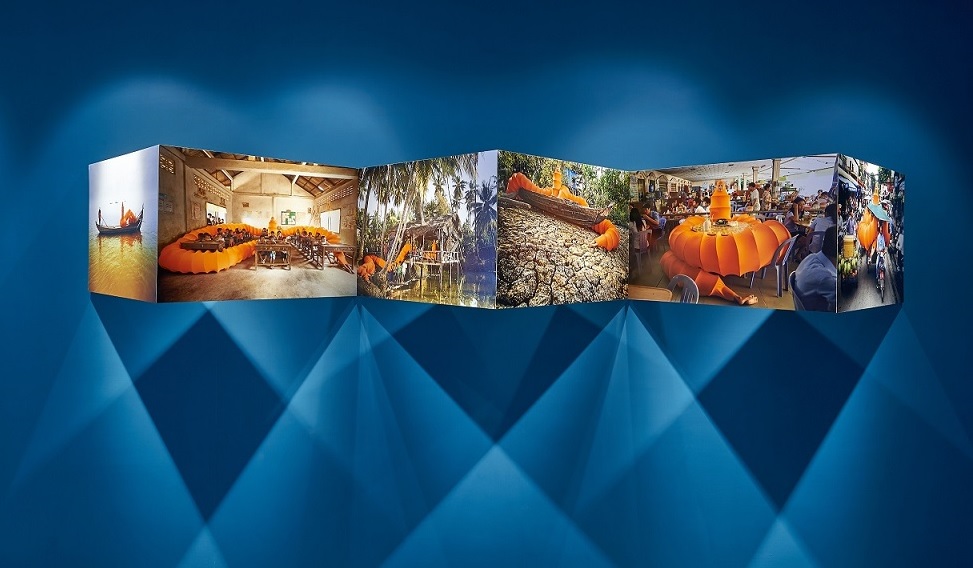
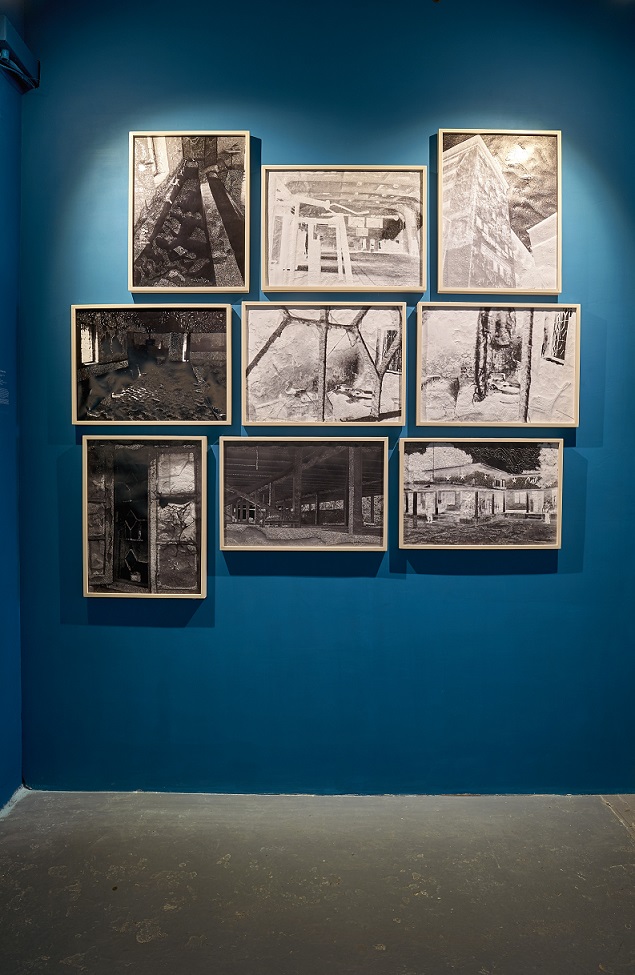

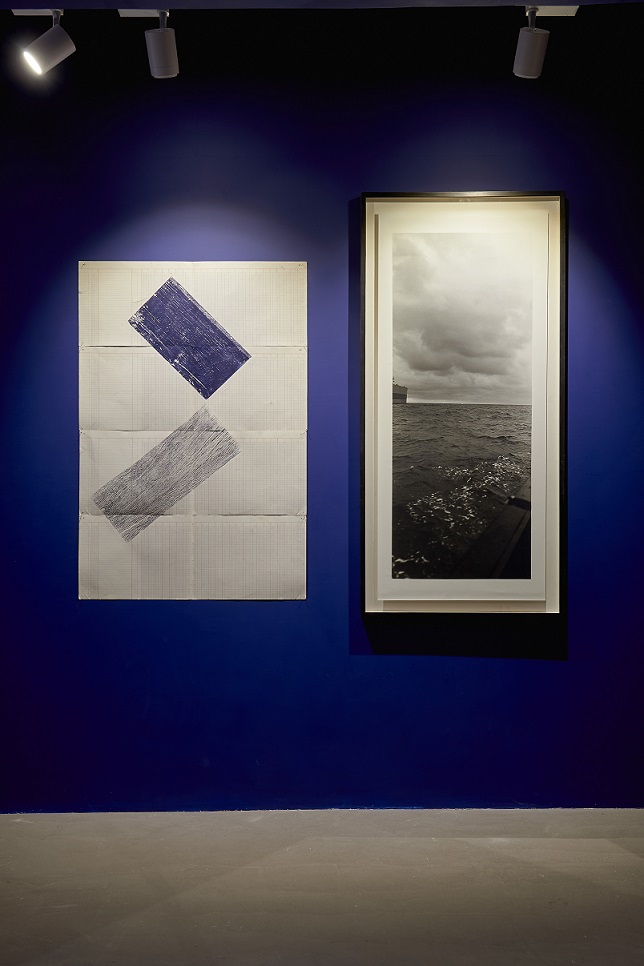
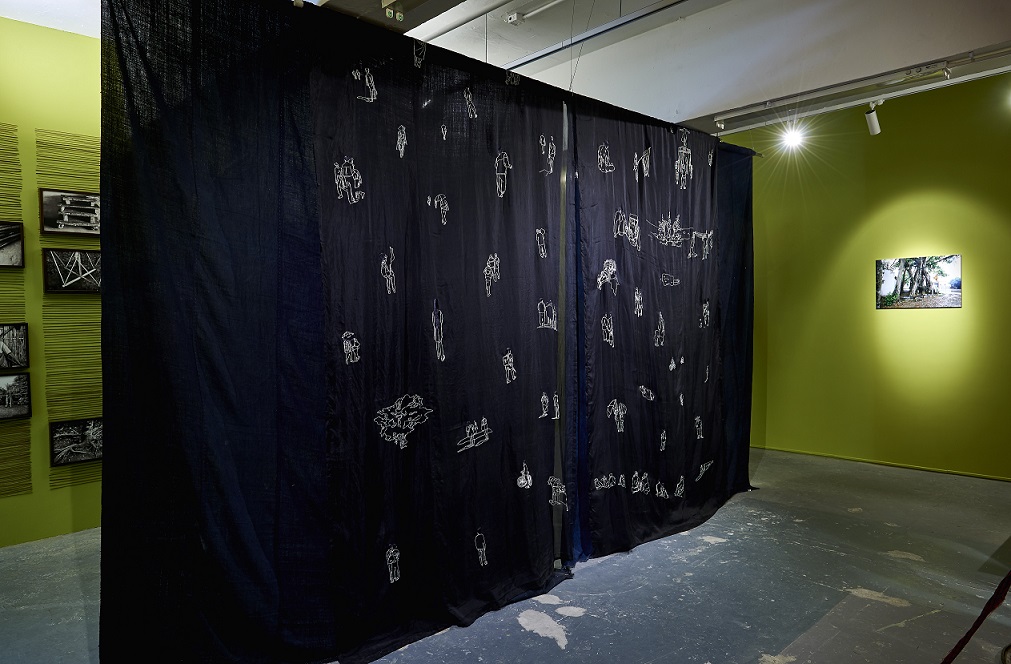
Captions:
1. Anida Yoeu Ali, From the Buddhist Bug Series, 2012 – 2014, Digital C-print, Courtesy of the artist /《佛蟲》系列, 數碼彩印, 由藝術家提供
2. Dilara Begum Jolly, The War that Never Went Away, 2016–17, Pierced photographs, Courtesy of the Samdani Art Foundation /《從未走遠的戰爭》, 穿孔相片, 由桑塔尼基金會提供
3. Garima Gupta, Hamas?, 2017, Charcoal on Manjar-Pat cotton cloth, Courtesy of the artist and Tarq, Mumbai, 《Hamas? 》, 炭筆、Manjar-Pat 棉布, 由藝術家及孟買 Tarq 畫廊提供
4. Simryn Gill, Pressing In, 2016, Relief prints on paper / 《壓入》, 紙上浮雕壓, Sweet Chariot, 2015/16, Silver gelatin print, Courtesy of the artist and Jhaveri Contemporary / 甜蜜雙輪戰車, 銀鹽沖,由藝術家及Jhaveri Contemporary 畫廊提供
5. Thao-Nguyên Phan, Man Looking Towards Darkness, 2014, Curtain made from Indigo dyed jute fabric, silk, hand embroidery, framed document, photograph, Courtesy of the artist / 潘濤, 《望向黑暗的男子》, 靛青染色的黃麻布簾、絲綢、手工刺繡、裝裱文件、攝影, 由藝術家提供
All images: Eddie Lam, Image Art Studio.
(原文以英文發表,評論Para Site藝術空間「一獸、一神、一線」展覽。)
In saffron, teal, cerulean, fuchsia, and more colors, objects of dignity stand tall, bursting with energy of the worldly and otherworldly. A god, a beast, a line is grounded upon secular political aspirations as much as spiritual pursuit. Fifty-five artists (and more to the count if collaborators acknowledged in many works are also included) show how dignity has its place in art.
Close to the entrance of one gallery of the three that comprise the entire show are Simryn Gill’s Pressing In (2016) and Sweet Chariot (2015/16). Pressing In is an imprint of two blocks of wood on accounting ledger paper. From afar, they look solid. A closer look reveals the grains in the blue, scorched by the sun, touched by the ocean, chewed perhaps by a microbe here and here, or cracked open by some unidentifiable human intent. No matter, the lines on the ledger paper have no trouble holding up the blue. To the right of Pressing In is Sweet Chariot in black and white. The photograph places the horizon in the middle and in context. It could be read as either being contained or cut off on one end by the bulwark of what seems to be a gigantic cargo ship. The rim of another boat from which the camera acts registers the changing distance between itself, the ship, and the horizon. In relation to the horizon as one thin line, the tactility of the blue mass is sharpened; that which has been adrift preserves its composure. In relation to the blue imprints, the horizon allows infinitude to persist as reality. As an invitation of perceptual shifts, the works abstract the ardor of the seafarers’ labor at the same time that they register the indeterminate destiny of its value.
Humans are on the move as animals are, but in this case, not according to nature but against nature. Garima Gupta’s body of work on the Bird of Paradise from New Guinea are at once studies of the species itself and a revelation of the brutality they have been subjected to while being traded to Europe for adorning women’s hats in the late 19th century and early 20th century. [1] One set of drawings shows each bird individuated, named, enlivened, gazing out. Another set on a meters-long canvas shows lines of them, each impregnated in the luxuriance of feather. Most of these birds have their eyes closed; it is not clear if the artist is depicting them as asleep or dead. While organized on the canvas as if they were specimens, each bird is a whole figure, rather than being anatomically dissected and analyzed. In gestures of rounding the birds, the artist confers another life upon her fellow beings – once captivated, now freed.
Transformative moments that awaken memories of oppression keep coming through. Thao-Nguyen Phan’s Man Looking Through Darkness is a curtain made of indigo dyed jute fabric, on which bodies that are wounded and tortured, thinking, waiting and walking singularly or shoulder-to-shoulder are embroidered. The silk stiches shine in the darkness of the curtain, evoking the history of the Japanese occupation of Vietnam from 1940-45, when jute cultivation and manufacturing displaced and uprooted the cultivation of rice, causing a famine in 1945 that killed two million Vietnamese. [2]
Dilara Begum Jolly’s The War that Never Went Away is a set of pierced photographs of desolate corners and rooms in the Physical Training College of Dhaka, “used as a site to torture Bangladeshi freedom fighters by the Pakistani army during the conflict” [3] in the Bangladesh War of Liberation in 1971. The pierces are distributed unevenly but orderly on the black and white patches of the images. The pierces punctuate and cause protrusion at the same time, abrading the photographic surface. One could imagine the artist, then eleven years old, trying to connect with the freedom fighters in their suffering by making the silence of the hollow space echo.
In confronting the complex histories of violence, the exhibition effectively challenges three dichotomies of thinking about cultural and political expression. The first dichotomy regards the division between the so-called Western and non-West values (and by extension, the West and the Anti-West). The many struggles addressed by the artists resonate with Amartya Sen’s argument in Identity and Violence: the Illusion of Destiny (2007) that there is nothing particularly Western about the yearning for liberty and public reasoning. So too does the so-called “non-West” aspire to a life of autonomy. The reasons to reject “Western” values from the position of the “Anti-West” would therefore also falter.
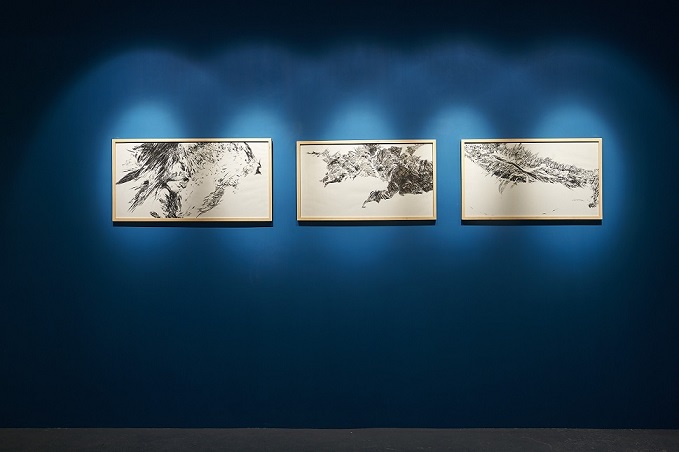
Tuguldur Yondonjamts, Smuggled landscape #09, #10 and #13, 2015, Charcoal on paper, Courtesy of the artist/ 走私的風景#09、#10和#13, 紙面炭筆, 由藝術家提供
The second dichotomy regards religious faith and rationality. The use of reason does not have to be premised on the abandonment of faith, and the power of reasoning that is perceived to be value-free is not the only path for liberation. Faith, on the other hand, involves reason; it is not its enemy but its ally. To involve faith in aspirations of freedom is to address the limits of human knowledge – not because of something already established in the past, but because of what is yet to be known in the future. Tuguldur Yondonjamts’s Smuggled Landscape, for instance, is a result of his training in Buddhist thangka painting and the idea of maya – “modes of shifting perspectives” [4] which allude to the histories of their suppression by authoritarian regimes, now, re-activated. Anida Yoeu Ali’s Buddhist Bug Series concerns itself with religious fundamentalism by appealing to multiple belief systems in Cambodia. The site responsive performances and photographic works engender mini-publics around shared urban myths that could be iconographic and iconoclastic at the same time.
The last dichotomy regards the ideas of the traditional and the contemporary in art. When encountering objects that have come through particular material histories that are culturally specific, one may be tempted to refer to them as cultural artifacts, to protect their diversity from being glossed over by an unexamined idea of art in general. The curatorial statement offers assistance to thinking and acting beyond the dichotomy: “In spite of the exhibition’s diversity of positions, A beast, a god, and a line is not based on an ethos of discovering or introducing artists from presumably marginalized regions, but by working within the premise of an already fragmentary and decentralized art world.” The complex and overlapping worlds the objects have come through demand complex understanding, without which each artist’s vision would not have been adequately presented. It is precisely in fragmentation that multiple disruptive possibilities in unfinished processes of both tradition and art making could be identified, affirming the present and orienting it towards the future. [5]
To close, I would like to return to the idea of dignity. Dignity: “The quality of being worthy or honorable; worthiness, worth, nobleness, excellence.” [6]. In his discussion of dignity as the moral and legal ground and content of rights in a civil society, Jeremy Waldron says, “A good account of human dignity […] will generate an account of it as noble bearing and an account of the importance of the ban on humiliating and degrading treatment.” Dignity, “comparable to a rank of nobility – only a rank assigned to every human person, equally without discrimination: dignity as nobility for the common man.” [7] Dignity in A god, a beast, a line arises out of multiple sources: from human agency to the animalistic, natural, and otherworldly. Hope is set in motion by dignity, not for transcendence, but for living the future, albeit uncertain, as self-determined.
If “a beast”, the exhibition is a reminder of beasts as emblems of human fear, and while we participate in our own monstrification, we may also find the possibility that fear could end from within ourselves. If “a god”, the exhibition summons experiences of the numinous in general, registering human limitations. If “a line”, the exhibition is a perforated line, showing parts which could be torn off by choice or out of necessity; alternatively, a line could address the infinite extent of any line, out of reach by our senses, but imaginable.
Along the line, I have wondered about the place of colors that are simultaneously the material reality of the works and the conceptual scaffolding of the entire exhibition. When dignity shows its color, “What form of love [does] it give or demand?” [8]
Notes
[1] A beast, a god, and a line exhibition catalogue. Hong Kong: Parasite. 2018:31.
[2] ibid., p. 54.
[3] ibid., p. 34.
[4] ibid., p. 79.
[5] Hirokazu Miyazaki. The Method of Hope: Anthropology, Philosophy, and Fijian Knowledge. Stanford: Stanford University Press. 2004:16.
[6] Oxford English Dictionary (www.oed.com), accessed April 26, 2018.
[7] Jeremy Waldron. Dignity, Ranks, and Rights. Oxford: Oxford University Press. 2012:22.
[8] In his discussion of the “blackened puppet” unearthed by a twelve-year-old boy in Russell Hoban’s novel Riddley Walker, Kenneth Gross recalls seeing, in a museum, a tiny marionette made by prisoners in a Nazi concentration camp. This is one of the questions he asks about this figure. See Puppet: An Essay on Uncanny Life. Chicago: University of Chicago Press. 2012:116.
First published in CoBo Social, May 2018
